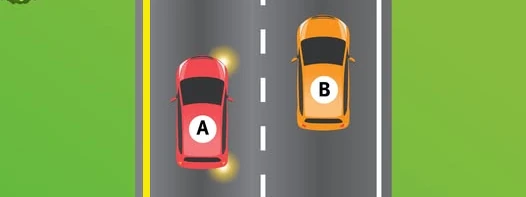 This incident took place at the intersection of Canada Way and Rosewood Street in Burnaby. It involved three vehicles, two of which changed lanes as their drivers did not want to wait for left turning traffic ahead of them. Those lane changes resulted in a crash involving the third vehicle traveling straight through using the right lane.
This incident took place at the intersection of Canada Way and Rosewood Street in Burnaby. It involved three vehicles, two of which changed lanes as their drivers did not want to wait for left turning traffic ahead of them. Those lane changes resulted in a crash involving the third vehicle traveling straight through using the right lane.
Vehicle #1
Ms. Ng was waiting in the left lane of Canada Way behind traffic that was making a left turn in the vicinity of the Rosewood Street intersection.
Vehicle #2

Ariel Alagar approached, also in the left lane. He saw the traffic that had stopped ahead of him and made a lane change to the right in order to pass by. Once he was completely engaged in the right lane, Ms. Ng changed lanes in front of him, causing him to come to a stop to avoid colliding with her.
Vehicle #3
Fraser Mackay was traveling in the right lane of Canada Way and collided with the rear of Mr. Alagar's vehicle after the lane changes were made ahead of him.
Be Prepared for Lane Changes
Justice MacNaughton found that Mr. Alagar had made a proper lane change and that Mr. Fraser was aware of potential risk because he could see the right hand signals of traffic in the left lane wanting to move right around the left turning traffic.
Mr. Mackay should have been immediately aware of the need for caution. It was not unexpected that one or more of the drivers in the left lane would move in front of him. In fact, a driver doing so was a significant possibility. Mr. Mackay should have begun to slow down anticipating such a lane change.
Mr. Alagar Did Not Contribute to the Crash
Mr. Fraser was not able to establish contributory negligence on the part of Mr. Alagar.
In the circumstances, Mr. Alagar’s conduct in initiating the lane change and then suddenly braking in response to Ms. Ng’s attempt to change lanes in front of him was not a failure to meet the standard of care required for his own protection. He was entitled to assume that Mr. Mackay, in the following car approaching from the rear, would react promptly to the change and the possibility of a sudden stop. He was also entitled to assume that Mr. Mackay was travelling at a distance and at a speed which would allow him to stop in time to avoid a collision as Mr. Mackay was aware of traffic stopped in the left lane and signalling to make a lane change. In all of the circumstances, I find no contributory negligence on Mr. Alagar’s part. Unexpected driver manoeuvres are part of city driving on a busy road, in the evening.
Learn More
Share This Article
- Log in to post comments
